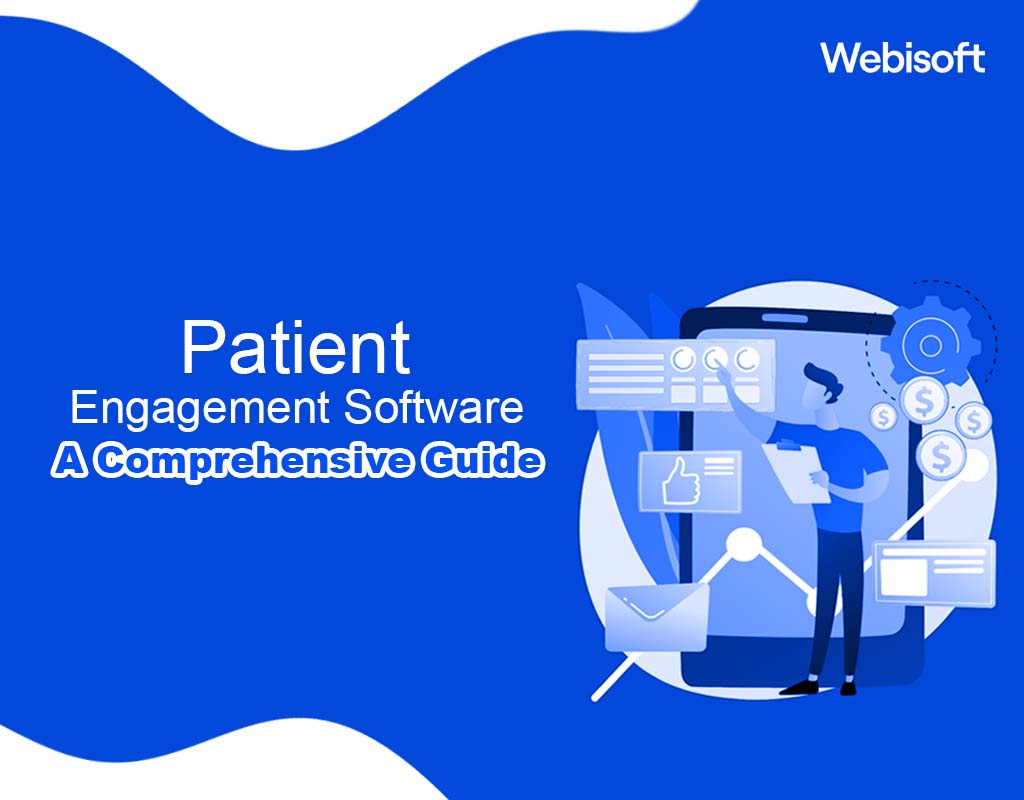The healthcare sector is constantly evolving. “Patient engagement software” is a term gaining immense popularity. This technology is innovative and transformative.
It’s changing how healthcare providers and patients interact. The result? Better communication, improved health outcomes, and increased patient satisfaction.
But what is a patient engagement platform? Why is it crucial in today’s healthcare environment? Let’s explore these questions in detail.
Contents
- 1 What is A Patient Engagement Platform?
- 2 Why is the Patient Engagement Platform Essential?
- 3 Benefits of Patient Engagement Platform
- 4 Features of the Patient Engagement Platform
- 5 Technologies Involved in the Development of Patient Engagement Platform
- 6 Implementing A Patient Engagement Platform Successfully
- 7 Compliances for the Patient Engagement Platform
- 8 Choosing the Right Patient Engagement Software Development Company
- 9 End Note
What is A Patient Engagement Platform?
In the realm of healthcare, patient engagement platforms serve as digital solutions. These platforms foster active patient involvement and bridge the communication chasm between patients and healthcare providers.
The result is an empowered patient actively managing their health. Let’s delve deeper into the role and functionality of these platforms.
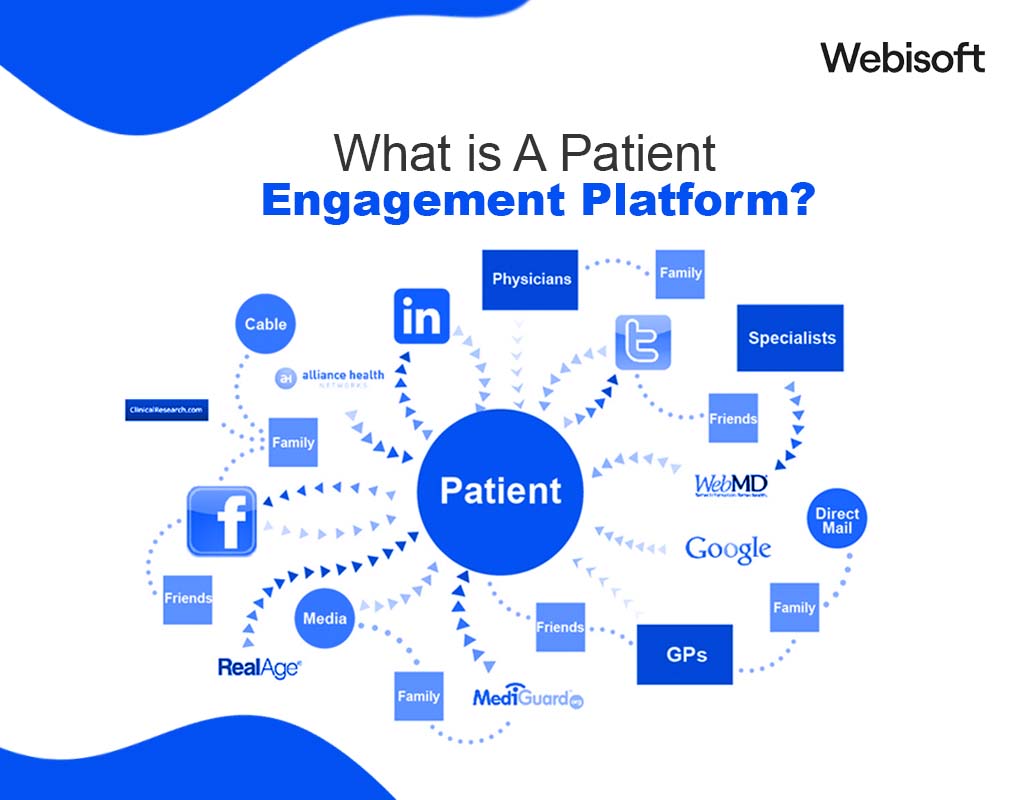
The Significance of Patient Engagement Platforms
Communication forms the bedrock of robust patient-provider relationships. Patient engagement platforms enhance this communication, providing a secure, convenient channel for interaction.
Questions, concerns, and advice flow freely, fostering a collaborative healthcare environment. Managing healthcare can be a complex task involving appointments, medications, and health records.
Patient engagement platforms simplify this process. They offer a centralized platform for healthcare management, enabling patients to schedule appointments, set medication reminders, and access health records.
Simultaneously, healthcare providers can update health records, send appointment reminders, and monitor patient progress. Empowerment plays a pivotal role in healthcare.
Empowered patients are more likely to participate in their healthcare journey actively. They adhere to treatment plans and make healthier lifestyle choices. Patient engagement platforms serve as empowerment tools, giving patients control and encouraging responsibility.
The Comprehensive Solution: Patient Engagement Platforms
Patient engagement platforms offer more than just digital tools. They provide a comprehensive solution to patients’ and healthcare providers’ diverse needs.
These platforms come equipped with various features designed to enhance the patient experience. Appointment scheduling, medication reminders, secure messaging, and health record access are just a few. These features make healthcare more accessible and manageable for patients.
For healthcare providers, these platforms offer operational benefits. They streamline operations, reduce administrative tasks, and allow healthcare providers to focus on patient care.
The Transformative Impact of Patient Engagement Platforms
The impact of patient engagement platforms is significant. They enhance patient-provider communication, improve patient satisfaction, and lead to better health outcomes.
In conclusion, patient engagement platforms are transformative tools in healthcare. They are changing the way healthcare is delivered and experienced. By making healthcare more patient-centric, they empower patients. These platforms are paving the way for a healthier future.
Why is the Patient Engagement Platform Essential?
Understanding the essential nature of patient engagement platforms requires a deep dive into their benefits. These platforms empower patients, leading to improved health outcomes.
They also enhance the efficiency of healthcare services. Let’s explore these aspects in more detail.
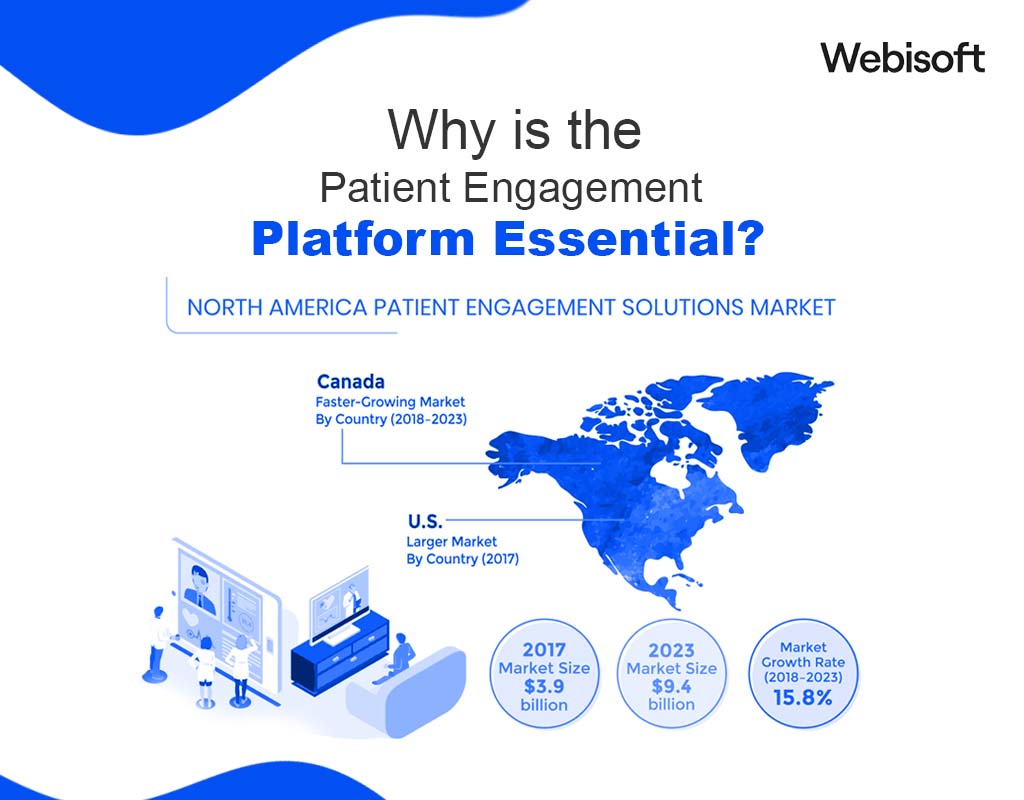
1. Empowering Patients
Patient empowerment stands at the forefront of these platforms’ benefits. Access to health records, the ability to schedule appointments, and communication tools are all at a patient’s fingertips.
This access fosters a sense of ownership and responsibility toward one’s health. Patients become active and energetic participants in their healthcare journey, not just passive recipients.
2. Improving Health Outcomes
Improved health outcomes are a direct result of patient empowerment. They are more likely to manage their health proactively. All these factors contribute to improved health outcomes.
3. Enhancing Efficiency
Efficiency in healthcare services is another significant benefit of patient engagement platforms. By streamlining administrative tasks, these platforms allow healthcare providers to focus on patient care.
Appointment scheduling becomes a breeze. Communication with patients becomes more straightforward. Health records are updated and accessed with ease.
The result is a more efficient healthcare service benefiting patients and healthcare providers.
4. Fostering a Sense of Ownership
A sense of ownership and responsibility toward one’s health is a powerful motivator. When patients feel they have control over their healthcare, they are more likely to take an active role.
They are more likely to follow through with treatment plans. They are more likely to communicate openly with healthcare providers. Patient engagement platforms foster this sense of ownership.
5. The Broader Impact
The broader impact of patient engagement platforms extends beyond individual patients and healthcare providers. These platforms are transforming the healthcare sector as a whole.
They are driving a shift towards a more patient-centric model of healthcare. They are making healthcare more accessible and convenient. They are improving the quality of healthcare services.
Patient engagement platforms are more than just digital tools. They are essential components of modern healthcare. They empower patients, improve health outcomes, and enhance the efficiency of healthcare services.
They foster a sense of ownership and responsibility toward one’s health. They are paving the way for a healthier future.
Benefits of Patient Engagement Platform
Patient engagement platforms bring a plethora of benefits to the table. From improved communication to better health outcomes and increased patient satisfaction, these platforms are revolutionizing healthcare.
Let’s delve into these benefits in more detail.
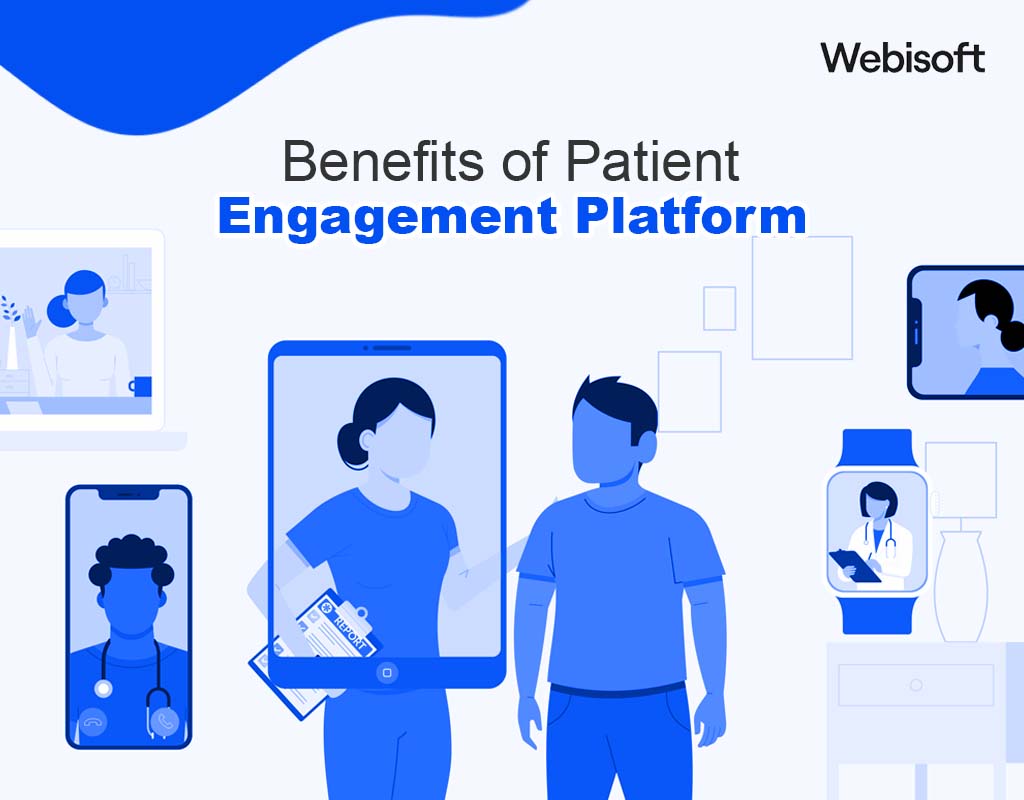
1. Enhanced Communication
One of the primary benefits of patient engagement platforms is the improved communication they facilitate. These platforms provide a secure and convenient channel for interaction between patients and healthcare providers.
This ease of communication fosters a collaborative environment where patients feel heard and understood. Healthcare providers can share important information, provide updates, and offer advice through these platforms.
Patients, on the other hand, can ask questions, express concerns, and provide feedback. This two-way communication enhances the patient-provider relationship, leading to better healthcare management.
Moreover, these platforms offer various communication tools, such as secure messaging, video consultations, and discussion forums. These tools cater to patients’ diverse communication needs and preferences, making healthcare more accessible.
2. Better Health Outcomes
Patient engagement platforms play a significant role in improving health outcomes. Engaged patients, who actively participate in their healthcare, are likely to adhere to effective treatment plans.
These platforms provide patients with the correct tools and resources. Using these, they need to manage their health effectively. They offer features such as health record access, medication reminders, and health tracking tools. These features enable patients to monitor their health, follow their treatment plans, and make informed healthcare decisions.
The result is improved health outcomes. Studies have shown that patient engagement leads to better management of chronic conditions, fewer hospital readmissions, and improved quality of life.
3. Increased Patient Satisfaction
Patient engagement platforms contribute significantly to enhancing patient satisfaction. These platforms foster a sense of ownership and empowerment by providing patients with control over their healthcare.
Patients appreciate the convenience and accessibility these platforms offer. They value the ability to schedule appointments, communicate with healthcare providers, and access their health records at their fingertips.
They appreciate the transparency and autonomy these platforms provide. Moreover, these platforms offer personalized healthcare experiences. They allow healthcare providers to tailor their services to each patient’s individual needs and preferences.
This personalization enhances patient satisfaction and loyalty. Patient engagement platforms offer numerous benefits. They enhance communication, improve health outcomes, and increase patient satisfaction.
They empower patients, making them active participants in their healthcare. And they streamline healthcare management, making it more efficient and effective. They transform the healthcare experience, making it more patient-centric and personalized.
We can expect more features, more integration, and more customization. We expect patient engagement platforms to become integral to healthcare, driving a shift towards a more patient-centric healthcare model.
And we can expect a healthier future where patients are empowered, healthcare is efficient, and satisfaction is high.
Features of the Patient Engagement Platform
Patient engagement platforms boast a wide array of features. From appointment scheduling to medication reminders, secure messaging, and health record access, these platforms are designed to make healthcare more accessible and manageable for patients.
Let’s explore these features in more detail.
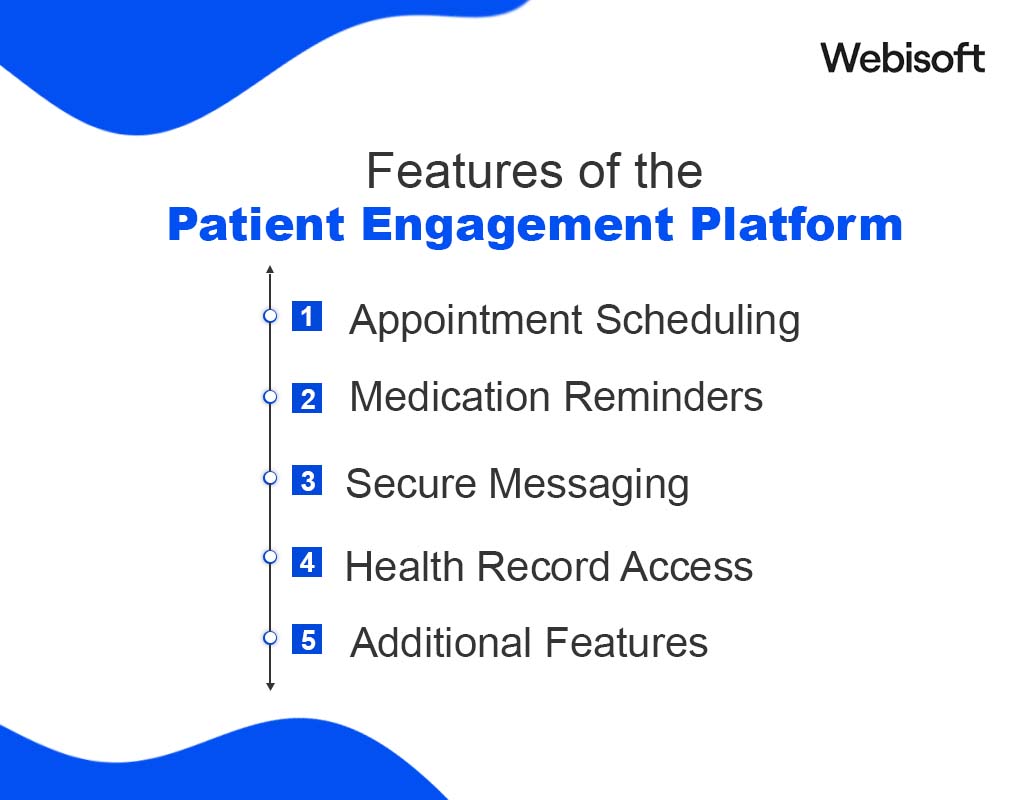
1. Appointment Scheduling
One of the key features of patient engagement platforms is appointment scheduling. This feature allows patients to book, reschedule, or cancel appointments at their convenience.
Patients no longer need to call during office hours or wait on hold. With a few clicks, they can manage their appointments anytime, anywhere.
For healthcare providers, this feature streamlines the scheduling process. It reduces administrative tasks, freeing up staff to focus on patient care. It also reduces no-shows, as patients receive automated reminders for their appointments.
2. Medication Reminders
Medication adherence is crucial for effective treatment. Yet, many patients struggle to remember to take their medications on time. This is where medication reminders come in.
This feature sends automated reminders to patients, ensuring they never miss a dose. For healthcare providers, medication reminders offer a way to monitor patient adherence.
They can track whether patients take their medications as prescribed and intervene if necessary.
3. Secure Messaging
Communication is key in healthcare. Secure messaging provides a safe, HIPAA-compliant communication channel for patients and healthcare providers. Patients can ask questions, express concerns, or seek advice.
Healthcare providers can provide timely responses, share updates, or offer guidance. Secure messaging enhances the patient-provider relationship.
It fosters a collaborative environment where patients feel heard and understood. It also makes healthcare more accessible, as patients can communicate with their healthcare providers at their convenience.
4. Health Record Access
Access to health records is another important feature of patient engagement platforms. This feature allows patients to view their health records anytime, anywhere.
They can track their health progress, review test results, or share their records with other healthcare providers. This feature offers healthcare providers a way to keep health records updated.
In real-time, they can add new information, such as test results or medical notes. They can also monitor patient progress and make informed decisions based on comprehensive health records.
5. Additional Features
Beyond these key features, patient engagement platforms offer additional features. These may include health-tracking tools, educational resources, telemedicine capabilities, etc.
These features cater to patients’ diverse needs and preferences, enhancing the patient experience. The features of patient engagement platforms are designed to make healthcare more manageable for patients.
They streamline healthcare management, making it more efficient and effective. They transform the healthcare experience, making it more patient-centric and personalized.
As technology continues to evolve continuously, so will the features of these platforms. We can expect more features, more integration, and more customization.
We expect patient engagement platforms to become integral to healthcare, driving a shift towards a more patient-centric healthcare model. And we can expect a healthier future where patients are empowered, healthcare is efficient, and satisfaction is high.
Technologies Involved in the Development of Patient Engagement Platform
The development of patient engagement platforms is a complex process. It involves the integration of various technologies, including cloud computing, mobile applications, and data analytics.
These technologies work harmoniously to create a seamless and efficient patient engagement experience. Let’s delve into how these technologies contribute to developing patient engagement platforms.
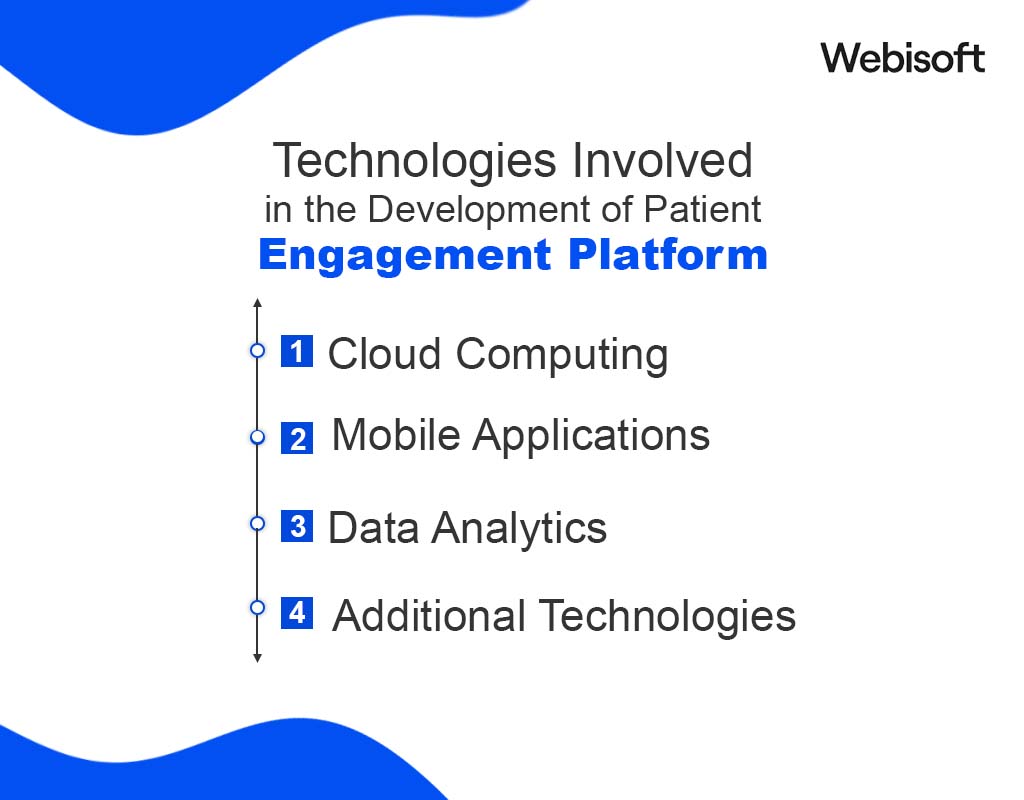
1. Cloud Computing
Cloud computing plays a role in the development of patient engagement platforms. This technology provides the infrastructure needed to host and manage these platforms.
With cloud computing, patient engagement platforms can be accessed anytime, anywhere. This accessibility is crucial in making healthcare more convenient for patients.
Moreover, cloud computing offers scalability. As the number of users increases, the platform can quickly scale up to meet the demand. This scalability ensures that the platform remains efficient and responsive as it grows.
Cloud computing also provides robust security measures. Patient’s sensitive data needs to be protected. Cloud computing offers advanced security features, such as encryption and access controls.
2. Mobile Applications
Mobile applications are another key technology in the development of patient engagement platforms. These applications provide a user-friendly interface for patients to interact with the platform.
They offer features such as appointment scheduling, medication reminders, secure messaging, and health record access, all at a patient’s fingertips.
Mobile applications also offer the advantage of push notifications. These notifications can be used to send appointment reminders, medication reminders, or important updates. This feature enhances patient engagement and adherence.
3. Data Analytics
Data analytics is a powerful tool in the development of patient engagement platforms. This technology allows healthcare providers to analyze patient data and gain insights.
These insights can be used to personalize healthcare services, improve patient outcomes, and enhance patient satisfaction.
Data analytics can also be used to monitor patient engagement. Healthcare providers can track patients’ platform use, identify trends, and make improvements.
This data-driven approach ensures that the platform will continuously meet the patient’s and healthcare provider’s needs.
4. Additional Technologies
Beyond cloud computing, mobile applications, and data analytics, other technologies also contribute to developing patient engagement platforms. These may include artificial intelligence, machine learning, blockchain, and more.
These technologies offer additional capabilities like predictive analytics, automated workflows, and secure data sharing.
In conclusion, developing patient engagement platforms involves a blend of various technologies. These technologies work together to create a seamless and efficient patient engagement experience.
They make healthcare more accessible and manageable for patients. And they streamline healthcare management, making it more efficient and effective. They transform the healthcare experience, making it more patient-centric and personalized.
As technology continues to evolve, so will patient engagement platforms. We can expect more features, more integration, and more customization.
Moreover, we expect patient engagement platforms to become integral to healthcare, driving a shift towards a more patient-centric healthcare model. And we can expect a healthier future where patients are empowered, healthcare is efficient, and satisfaction is high.
Implementing A Patient Engagement Platform Successfully
Implementing a patient engagement platform successfully is a complex process. It requires careful planning, stakeholder involvement, and continuous evaluation.
Moreover, choosing a platform that aligns with the healthcare organization’s needs and goals is crucial. Let’s explore these aspects in more detail.
1. Careful Planning
The first step towards successful implementation is careful planning. This involves defining the objectives of the platform. What are the expected outcomes?
How will the platform improve patient engagement? How will it enhance healthcare services? Answering these questions helps in setting clear, measurable goals.
Next, a detailed implementation plan needs to be developed. This plan should outline the steps for implementation, the timeline, and the responsibilities of each team member. It should also include a risk management plan to address potential challenges.
2. Stakeholder Involvement
Stakeholder involvement is another critical factor in successful implementation. This includes healthcare providers, administrative staff, and patients.
Healthcare providers are the primary users of the platform. Their input is crucial in choosing a platform that meets their needs. They can provide insights into the features they need, their challenges, and the expected improvements.
Administrative staff are responsible for managing the platform. Their involvement ensures that the platform aligns with the organization’s processes and workflows. They can also provide training and support to other users.
Patients are the end-users of the platform. Their feedback is invaluable in creating a user-friendly platform. They can provide feedback on the platform’s usability, features, and overall experience.
3. Continuous Evaluation
Continuous evaluation is essential for successful implementation. This involves monitoring the platform’s performance, gathering user feedback, and making improvements.
Performance monitoring helps in assessing whether the platform is meeting its objectives. Key performance indicators (KPIs) can be used to measure the platform’s effectiveness.
These may include patient engagement rates, patient satisfaction scores, and health outcome improvements. User feedback provides insights into the user experience. It helps in identifying any issues or challenges users are facing.
Based on the evaluation, improvements can be made to the platform. This could involve adding new features, improving usability, or addressing technical issues. This continuous improvement ensures that the platform remains effective and relevant.
4. Choosing the Right Platform
Choosing the right patient engagement platform is crucial for successful implementation. The platform should align with the healthcare organization’s needs and goals.
It should offer the features and capabilities that the organization requires. It should also be user-friendly, secure, and scalable.
In conclusion, successfully implementing a patient engagement platform involves careful planning, stakeholder involvement, and continuous evaluation.
It requires choosing a platform that aligns with the healthcare organization’s needs and goals. With the right approach, a patient engagement platform can transform healthcare services, improve patient engagement, and enhance patient satisfaction.
It can transform the healthcare experience, making it more patient-centric and personalized. And it can pave the way for a healthier future.
Compliances for the Patient Engagement Platform
Patient engagement platforms must adhere to various regulations, and choosing the right development company is crucial. Let’s delve into these aspects in more detail.
Patient engagement platforms handle sensitive patient data. Therefore, they must comply with various regulations. These regulations ensure the privacy and security of patient data. Let’s explore some of these regulations.
1. HIPAA Compliance
HIPAA is a key regulation in the United States. It sets standards for keeping and protecting sensitive patient data. Any entity dealing with protected health information must ensure all necessary physical, network, and process security measures are in place.
HIPAA compliance is crucial for patient engagement platforms. They must implement powerful security measures to protect patient data. This includes data encryption, access controls, and secure data transmission.
2. GDPR Compliance
Patient engagement platforms serving EU residents must comply with GDPR. They must ensure data privacy, obtain consent for data processing, and provide data portability.
They must also implement the right to be forgotten, allowing individuals to have their data erased.
Choosing the Right Patient Engagement Software Development Company
Choosing the right patient engagement software development company is crucial. Here are some factors to consider.
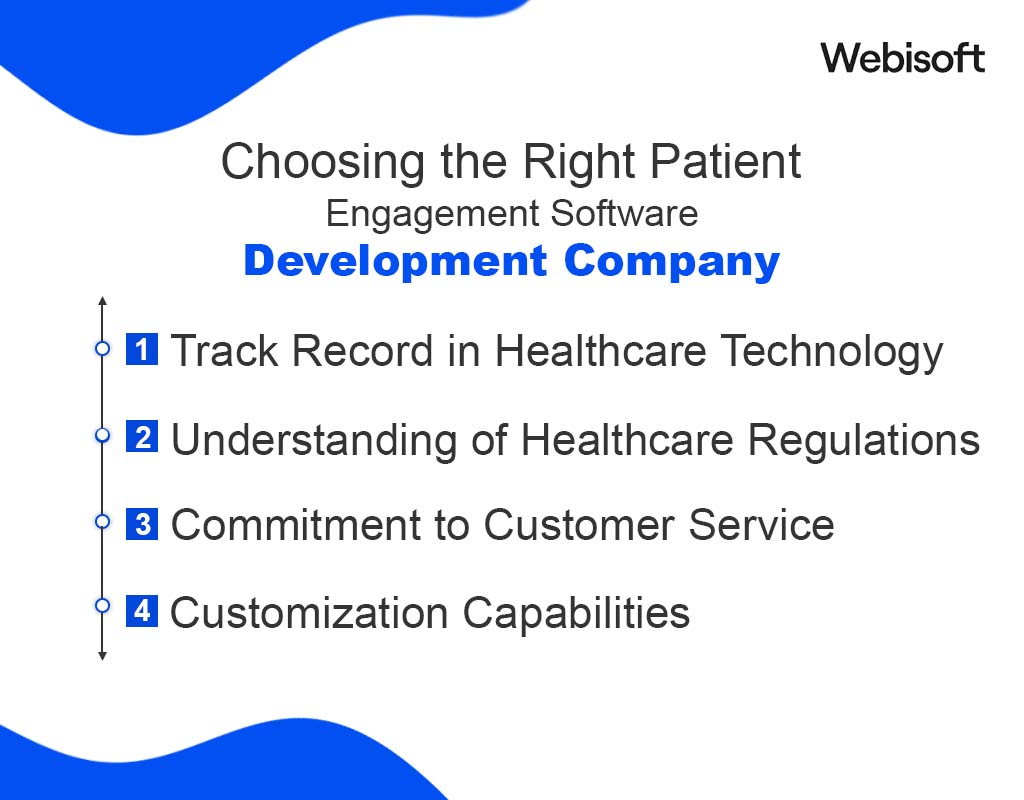
1. Track Record in Healthcare Technology
Look for a company with a proven track record in healthcare technology. This indicates the company’s experience and expertise.
Check client testimonials, portfolios, and case studies. This will give you an idea of their capabilities and the quality of their work.
2. Understanding of Healthcare Regulations
A deep understanding of healthcare regulations is crucial. The company must know regulations like HIPAA, GDPR, and more.
They must know how to build a platform that complies with these regulations. This ensures the privacy and security of patient data.
3. Commitment to Customer Service
A commitment to customer service is another important factor. The company should provide excellent customer support.
They should be responsive, helpful, and reliable. They should also offer training and support to help you use the platform effectively.
4. Customization Capabilities
Every healthcare organization has unique needs. The company should offer customization capabilities. They should be able to tailor the platform to meet your specific needs.
This ensures that the platform aligns with your processes and workflows. Patient engagement platforms must comply with various regulations to ensure the privacy and security of patient data.
Choosing the right patient engagement software development company is crucial. Look for a company with a proven track record in healthcare technology, a deep understanding of healthcare regulations, and a commitment to customer service.
With the right platform and development company, you can enhance patient engagement, improve healthcare services, and ensure a healthier future.
End Note
In conclusion, patient engagement software is a game-changer in the healthcare industry. It empowers patients, improves health outcomes, and enhances the efficiency of healthcare services.
As healthcare continues to evolve, patient engagement platforms will play a great role in changing the future of healthcare.
